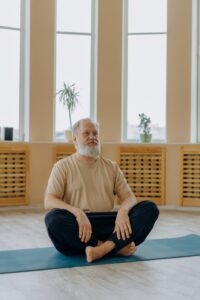
Yoga Tips for Seniors with Limited Mobility: Unlock the Power of Gentle Movement
Yoga is a time-honored practice that offers numerous benefits for people of all ages. For seniors, in particular, yoga can be a transformative tool for maintaining flexibility, promoting relaxation, and improving overall well-being. Even for those with limited mobility, there are gentle yoga poses and modifications that can be adapted to suit their needs. In this article, we will explore some valuable tips and techniques to help seniors with limited mobility embrace the power of yoga and experience its positive impact on their physical and mental health.
Gentle Yoga Poses for Seniors with Limited Mobility

Yoga Tips for Seniors with Limited Mobility
Seated Mountain Pose
The Seated Mountain Pose is an excellent starting point for seniors with limited mobility. It promotes proper posture and deep breathing while seated comfortably on a chair or yoga mat. Begin by sitting tall with feet flat on the ground and hands resting on the thighs. Close your eyes, take deep breaths, and focus on grounding yourself.
Chair Yoga: Seated Forward Fold
Chair yoga is a modified version of traditional yoga poses, specifically designed for individuals with limited mobility. The Seated Forward Fold is a gentle pose that stretches the back and hamstrings. Sit at the edge of a chair, inhale deeply, and as you exhale, slowly hinge forward from the hips, reaching towards your feet or the floor.
Standing Tree Pose with Support
The Standing Tree Pose with Support is an effective way for seniors to improve balance and stability. Stand near a wall or use a chair for support if needed. Shift your weight onto one leg, bend the opposite knee, and place the foot on the inner thigh of the standing leg. Find your balance, breathe deeply, and feel rooted like a tree.
Supine Leg Stretch
The Supine Leg Stretch is a gentle pose that helps stretch the legs and improve circulation. Lie down on your back, bend one knee, and hug it towards your chest. Straighten the opposite leg along the ground, feeling a gentle stretch in the hamstrings. Switch sides and repeat the stretch for the other leg.
Breathing Techniques for Relaxation and Mindfulness
In addition to physical poses, breathing techniques play a vital role in yoga practice. They help seniors with limited mobility cultivate relaxation, reduce stress, and increase mindfulness. Here are three simple yet effective breathing techniques:
Deep Belly Breathing
Deep Belly Breathing involves breathing deeply into the belly, allowing it to rise and fall with each breath. Sit or lie down comfortably, place one hand on your abdomen, and take slow, deep breaths. Feel your belly expand on the inhale and contract on the exhale, promoting relaxation and stress relief.
Equal Breathing
Equal Breathing, also known as Sama Vritti Pranayama, involves equalizing the length of inhalation and exhalation. Find a comfortable seated position, relax your body, and inhale deeply for a count of four. Exhale for the same count of four. Continue this rhythmic breathing pattern, focusing on the balance between inhalation and exhalation.
Alternate Nostril Breathing
Alternate Nostril Breathing, or Nadi Shodhana, is a technique that balances the energy channels in the body. Sit comfortably with your spine straight, use your right thumb to close your right nostril, and inhale deeply through the left nostril. Then, close the left nostril with your ring finger and exhale through the right nostril. Continue alternating nostrils for several breaths.
Importance of Props and Modifications
When practicing yoga with limited mobility, props and modifications are invaluable tools to support and enhance the practice. Here are a few examples of how props can be used:
Using Yoga Blocks and Straps
Yoga blocks and straps can provide support and stability during yoga poses. Blocks can be used to bring the floor closer when reaching down is challenging, and straps can assist in stretching and deepening certain poses. These props help seniors maintain proper alignment and prevent strain or injury.
Chair Modifications for Standing Poses
Seniors with limited mobility can modify standing poses by using a chair for support. For example, the Chair Warrior Pose involves stepping one foot back into a lunge position while holding onto the back of the chair for balance. This modification allows seniors to experience the benefits of standing poses while reducing the risk of falls.
Wall Support for Balance
Practicing yoga near a wall provides additional support and stability, especially for standing poses. Seniors can gently press their hands against the wall while performing balancing poses, helping them find stability and build confidence.
 Safety Precautions and Tips for Seniors Practicing Yoga
Safety Precautions and Tips for Seniors Practicing Yoga
Before starting any new exercise routine, including yoga, it is essential for seniors to take certain safety precautions. Here are a few tips to ensure a safe and enjoyable yoga practice:
Consulting with a Healthcare Professional
Seniors with pre-existing medical conditions or injuries should consult with their healthcare professional before starting yoga. They can provide guidance on modifications, restrictions, and any precautions specific to the individual’s health.
Practicing Mindful Movement
Seniors should practice yoga mindfully, moving with awareness and paying attention to their body’s signals. It is crucial to avoid pushing beyond their comfort zone and to respect any limitations imposed by limited mobility.
Listening to Your Body
Seniors should listen to their bodies and make modifications or take breaks as needed. It is essential to honor their physical boundaries and not force any movements that cause pain or discomfort.
Integrating Yoga into Daily Life: Simple Practices for Seniors
Apart from dedicated yoga sessions, seniors can integrate yoga into their daily lives with simple practices that promote well-being. Here are a few suggestions:
Morning Stretches and Gentle Movement
Starting the day with a few gentle stretches and movements can help seniors wake up their bodies and prepare for the day ahead. Simple exercises like neck rolls, shoulder stretches, and ankle circles can be done while sitting or standing.
Practicing Mindful Breathing throughout the Day
Seniors can cultivate mindfulness and relaxation by incorporating mindful breathing throughout their daily activities. Taking a few moments to focus on deep, conscious breaths can help reduce stress, improve focus, and enhance overall well-being.
Relaxation Techniques for Better Sleep
Seniors can use yoga techniques to promote better sleep and relaxation. Before bedtime, engaging in a gentle restorative pose, such as Legs-Up-The-Wall, and practicing deep breathing can help calm the mind and prepare the body for restful sleep.
Conclusion
Yoga offers seniors with limited mobility a gentle and accessible path to physical and mental well-being. By incorporating yoga poses, breathing techniques, props, and modifications, seniors can experience the benefits of yoga while respecting their bodies’ unique needs and limitations. Remember to approach yoga with patience, mindfulness, and a sense of joy. With regular practice, seniors can unlock the power of gentle movement and enhance their overall quality of life.









